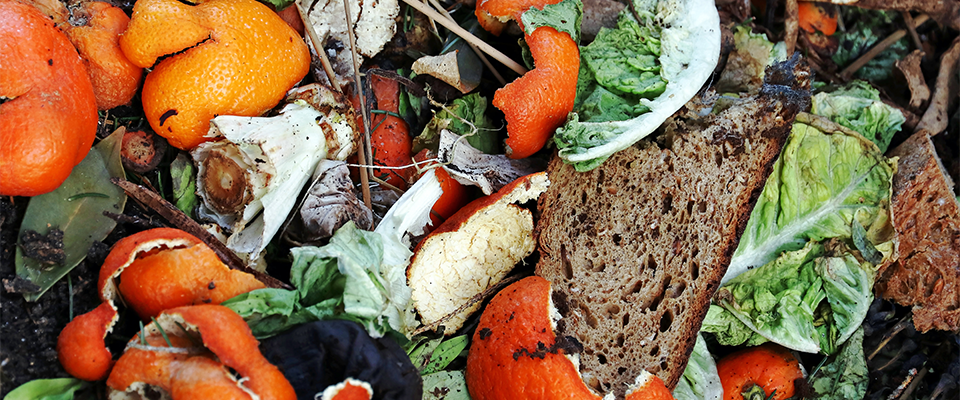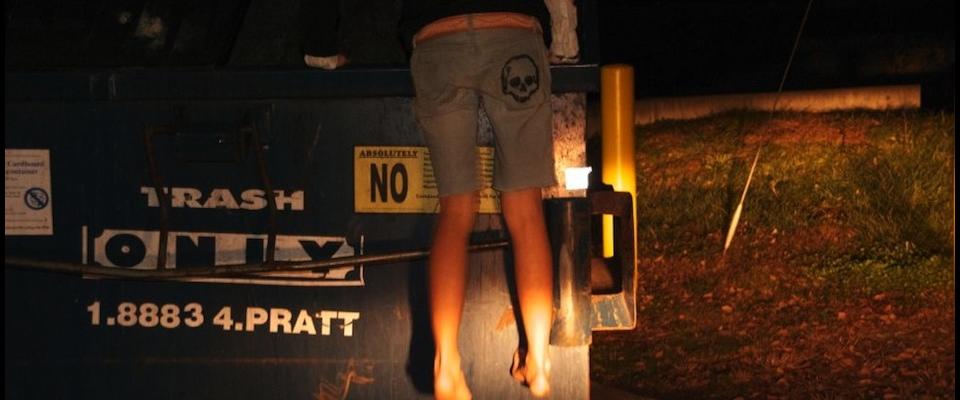No one likes to see good food go to waste.
Countless times we’ve been told to clean our plates or go without dessert, to equate “waste not” with “want not,” to “think of the starving children residing in some far away and unfortunate country.” Food waste represents not only money poorly spent and greenhouse gas needlessly emitted—more than a fifth of all landfill-bound trash is food, and landfills are the nation’s third largest source of methane gas—but lost potential and unnecessary suffering. The leftovers in your trashcan tell you a story about yourself that you do not wish to hear: your grocery bill was overly ambitious, your after-dinner slice of cake was ill-conceived and gluttonous, your children who refuse to eat their vegetables are spoiled and ungrateful.
But to Elise Golan, food waste looks like low-hanging fruit. Her mission as director of sustainable development for the US Department of Agriculture: Start picking.
Within the past year, she has helped launch the Food Waste Challenge—a campaign to coax companies, schools, and government agencies to keep more food out of landfills.
“The issue first caught my attention because I was reading so much about feeding the world in 2050, given our constrained resources and a growing population,” says Golan, who earned her Ph. D. in agricultural economics from UC Berkeley and was consulting for the World Bank at the time. Feeding the World by 2050 is a long-term, easy-to-remember goal often promoted by international development organizations such as the United Nations’ Food and Agriculture Organization.
“A lot of that literature on the issue would tick off the various things that we must do,” she says, “and up there in the top 10 was always ‘reduce food loss and food waste.’ ”
For an economist like Golan, the issue of food waste is a matter of inefficiency. On the one hand, the global food supply chain represents a massive expenditure of resources—financial, social, and ecological. On the other, an ever-larger, ever-richer global population creates ever more voracious demand for calories and nutrition. Between the two, food brought to market and then left uneaten represents too much slack in the system.
Participation in the Food Waste Challenge, a joint program of the USDA and federal Environmental Protection Agency, can be as much (or as little) as an interested organization wants it to be. They can sign up through the EPA, where they’ll find technical information and advice on how to cut back on waste, or they can sign up on the USDA’s web site, which seeks a specific pledge and an explanation of how the participant plans to meet its goal.
So far more than 100 organizations have signed up. Those include food giants like General Mills and Kellogg, major sports teams such as the Milwaukie Brewers and the Washington Capitals, and universities such as the University of Oregon, San Jose State, and UC Merced.

Pledges range from the modest (Northern Nevada’s Silver Stage Elementary School pledging to cut back on lunchtime waste) to the more ambitious (Unilever’s commitment to continue sending zero food waste to US landfills, a goal it says it reached in 2012.)
With the program approaching its first year anniversary, Golan is optimistic. “We have a goal of 400 (committed organizations) by the end of this year and 1,000 by 2020,” she says. “I am fully anticipating that we’ll make those goals.”
Beyond the list, Golan says the USDA has also taken steps to get its own house in order.
“These challenges are easy to make if you’re just asking other people to do something, but we also really wanted to look internally,” she says. “We wanted to try to assess whether any of our own programs are constraining the abilities of other organizations to reduce their food waste or causing even more food waste directly.”
Case in point: Between 2010 and 2012, a USDA regulatory guideline required any mislabeled meat and poultry to be sent back to the processor for relabeling, even when the company opted to forgo the cost and donate the meat to a food bank. As a result, the department detained some 3 million pounds of good meat.
As a part of the Food Waste Challenge, says Golan, the USDA will be changing that rule, along with dozens of other regulations and practices.
Still, by any measure, anti-food-waste advocates have a long way to go.
A recent USDA report offered a few new ways to measure the problem—and all of the results are discouraging. Of U.S. food produced in 2010 and then purchased at the retail and consumer level, an estimated 31 percent went uneaten. That comes out to 133 billion pounds of food destined for the landfill. (The biggest category, by weight? Dairy products.)
The report estimated the cost of that profligacy at $161.6 billion. (The biggest category, by price? Meat, poultry and fish.)
And for the calorie-counters among us, the report estimated the wasted food represented 387 billion calories per day. Divvied up amongst America’s 300 million-plus citizens, that’s 1,249 daily calories per person. Nutritional requirements aside (nearly half of those calories came in the form of added oils, fats, and sweeteners), that’s enough discarded food energy to get every American, if not through the entire day, than at least through lunch—year round.
All of this raises some uncomfortable questions about the relationship that most Americans have with their food.
“We’re talking about $161 billion dollars of waste. That is a huge amount of money that is essentially just being left on the table.”
While the government has labeled an estimated 15 percent of all American households “food insecure,” the February food loss estimates blame some of the waste on “consumer demand for high cosmetic standards,” consumers confused by ‘use-by’ and ‘best before’ dates and thus discarding food still safe to eat, and retailers “culling blemished, misshapen, or wrong-sized foods in an attempt to meet consumer demand.”
Of course, a certain amount of food loss is inevitable. While the 133 billion pound estimate does include the bulbous honey crisp considered too unsightly for consumption by America’s fickle shoppers, it also accounts for all the meat that comes from diseased animals and the plate scrapes leftover by restaurant customers. Chalk it up to overly cautious public health regulations, to the predictable surpluses of modern capitalism, or to the inevitable biological forces of rot and decay, but there will always be a few bad apples left at the bottom of the barrel.
But while there will always be a limit, Golan says we are nowhere near the limit. And that represents an opportunity.
“We’re talking about $161 billion dollars of waste. That is a huge amount of money that is essentially just being left on the table,” she says. “There have got to be innovators out there and business people thinking, ‘What can we do to capture some of that?’ ”
To help find some of those innovators, Golan says the USDA will host food waste “innovation expos” to highlight new production processes, delivery models, and technologies being used to cut down on food waste.
With its focus on private innovation, the Food Waste Challenge’s approach has been relatively restrained—inviting and encouraging and facilitating participation, rather than demanding or regulating it.
“As an economist, that’s really what I like to see,” says Golan. “I don’t have confidence that I would be able to tell a highly evolved industry player where their inefficiencies are in their supply chain or where the most innovative approaches ought to be directed. It’s a relatively light touch to governance, and rightly so.”
But that’s a little too light for some.
“We don’t need some crazy new technology. We have the food. People are hungry. Let’s connect the dots.”
“Why don’t we invest in the infrastructure to make sure that good food is redistributed within our communities?” asks Dana Frasz. As the founder of the Oakland non-profit Food Shift, Frasz and her colleagues have been trying to do just that at the local scale. She’d like to see a fee-for-service food recovery industry, in which businesses like restaurants and grocery stores pay for the privilege of having their unwanted perishables carted away to the food bank.
In practice, it’s not been an easy sell, says Frasz. The costs of wasted food, measured in methane gas or unmet hunger elsewhere, is not a cost born by grocery stores or restaurants. Instead they are “not held accountable for the true cost of their waste.”
Even so, FoodShift has had some luck both in the public sector, coordinating with a number of schools in the Oakland Unified School District to pick up their cafeteria leftovers, and, more recently, among the gourmand set, where consumers are more likely to cough up more for a greener product. According to Frasz, FoodShift is “very close” to signing a contract with Andronico’s. For a fee, the non-profit will either hire a driver directly or work alongside the San Francisco-based volunteer food recovery group, Food Runners.
But Frasz says tackling food waste one small partnership at a time is like “trying to put out this huge fire with a bucket.”
What’s needed instead is scale.
“We don’t need some crazy new technology. We have the food. People are hungry. Let’s connect the dots,” she says. “We’ve developed this whole system to pick up trash and this whole system to pick up recycling. The logistics and efficiency of those systems are incredible and hundreds of people are employed in the process. Why haven’t we set up a system like that for actual edible, good quality, nutritious food?”
The USDA champions organizations similar to FoodShift—such as Arlington, Virginia’s Food Bus and southern California’s Food Forward—although its role is just promotional.
But even simply as a vocal advocate, says Golan, the USDA’s voice is louder than most. Food waste wasn’t something that was on very many people’s radars just a few years ago.
These days, as she makes the rounds to meet with various executives working in the food industry, she says it’s “really hard to find somebody who isn’t aware of this issue.”
“Maybe I wouldn’t give us all the credit,” she says. “But along with the EPA, we have been beating the drum on this issue and I think, as a result of that, awareness and understanding really is growing.”




















